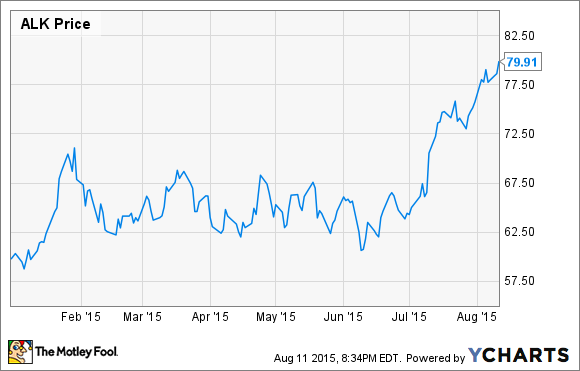
What: After being stuck in a relatively narrow trading range around $65 for most of 2015, shares of Alaska Air (ALK -0.99%) broke out in a big way in July. The stock jumped 17.6% during the month, according to S&P Capital IQ data.
Alaska Air year-to-date stock performance, data by YCharts.
The gains have continued so far in August, bolstered by Alaska's announcement of a new $1 billion share repurchase program that could potentially reduce share count by 10%. This has pushed Alaska stock to a new all-time (split-adjusted) high around $80.
So what: Alaska Air's stellar stock performance is a testament to its strong cost control and successful efforts to fend off rising competition at its main hub in Seattle.
After underperforming the industry in terms of unit revenue in 2014 due to stiff competition, Alaska posted a 5.6% unit revenue decline last quarter: not great, but still roughly in line with its main competitors. Meanwhile, non-fuel unit costs fell 3.5%, Alaska's fuel cost per gallon fell 33.8%, and fuel efficiency improved by about 2% (all on a year-over-year basis).
As a result, Alaska's adjusted earnings per share rose 56% year over year to $1.76, beating the average analyst estimate of $1.73. The analyst consensus for full-year EPS has risen from $6.01 to $6.23 in the past month.

Alaska Air posted better than 50% year-over-year EPS growth last quarter.
With Alaska's revenue performance starting to look better than that of many other airlines and competitive capacity growth in Seattle slowing, investors are starting to give the company more credit for its stellar margins and strong balance sheet. This has helped Alaska shares rise another 5.6% between the end of July and the close of trading on August 11.
Now what: Despite the recent stock price surge, Alaska Air stock trades for less than 13 times projected 2015 earnings. Additionally, the carrier continues to grow steadily and it has a culture of continuous unit cost improvement -- two factors that should help it to continue to grow earnings.
On the other hand, investors should continue to keep an eye on Delta Air Lines' domestic growth in Seattle. If it adds another big wave of growth there in 2016, it could cause further unit revenue pressure for Alaska Air that isn't likely to be offset by another huge drop in fuel costs.




